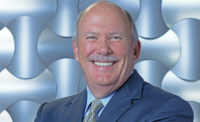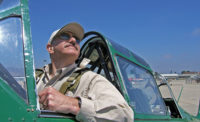The 15-year-old ACE Mentor Los Angeles/Orange County may never have existed if not for L.A.’s 1994 Northridge earthquake. The temblor damaged St. Vibiana’s Cathedral. That prompted the Roman Catholic Archdiocese of Los Angeles to build a replacement—a modern-day Noah’s Ark that would be a fully functional refuge for the people of L.A. after the “Big One.”
One of the individuals who helped convince the archdiocese to raise the extra funds required for a base-isolation system, which would allow the cathedral to ride out a magnitude-7.1 quake and provide space for some 500 post-quake refugees, was Terry Dooley.
A practicing Catholic, civil engineer Dooley was so committed to the notion of the Cathedral of Our Lady of the Angels as a refuge that he delayed retirement from Morley Construction Co. to lead the project. “The level of enthusiasm for the success of the job is unequaled in my 40-plus years of construction experience,” said Dooley at the time of the project (ENR 9/10/01 p. 42).
In 2001, Dooley met a reporter writing about the cathedral project, which was the first religious building on base isolators and the first religious building with 415,000 sq ft of architectural concrete. The reporter was also an ACE Mentor Program volunteer scouting for a champion to start a Los Angeles affiliate of the national program, which introduces inner-city high school students to careers in architecture, construction and engineering.
The ACE “scout” did not know that Dooley, then 71, was a civil rights activist. But his commitment to the cathedral as a refuge made him stand out not only as a modern-day Noah, but as the perfect ACE champion.
Several months later, when the cathedral work was winding down, Dooley had breakfast with the scout and Charlie Thornton, ACE’s chairman, before a symposium on seismic safety in Long Beach, Calif., that Dooley had chaired. During the meal, Thornton, the symposium’s keynote speaker, asked Dooley to start ACE Mentor LA. “I agreed to think it over,” says Dooley.
During Thornton’s Q&A, he announced to the 300 engineers in attendance that Dooley had agreed to start an ACE program. “I bounced to my feet and said I had agreed to think it over,” says Dooley. But “thus cornered, I said, ‘Yes,’ and have been at it ever since.”
The cathedral opened in September 2002, the same time ACE Mentor LA, recently renamed ACE Mentor LA/OC because its borders go beyond L.A. County, started up with three teams. This school year there are 26 teams with 400 students and 146 mentors. The program has given out $1 million in college scholarships.
The 87-year-old Dooley, currently the group’s director emeritus, has absolutely no regrets about his ACE experience. “It has enlivened my life,” says Dooley.
For having founded and grown ACE Mentor LA/OC and for his other accomplishments, ENR California is delighted to name Terry Dooley the recipient of its fourth annual Legacy Award, which recognizes enduring contributions of industry standouts to their professions, their communities and the built environment.
“From the first time you meet Terry, you know there is something remarkable about him,” says the semi-retired Bert Lewitt, chairman of the board of Morley Builders, which has supported Dooley’s ACE work from the outset. “He’s an incredible all-around person and is always interested in being helpful.”
Steve Smith, an executive vice president of contractor Hathaway Dinwiddie and ACE’s volunteer treasurer since the group’s inception, adds, “Terry is always looking out for the underdog.”
Dooley is a humanitarian. One example of his many causes was his work, in the 1960s, with the Fair Housing Council of the San Fernando Valley. “With my wife, Kathy, and the council, I worked to support the Rumford Act in California, opposing racial discrimination in housing,” says Dooley.
In 1964, the council lost its campaign to fight the act’s repeal. But the tide turned. “We saw the Rumford principles restored by federal legislation a few years later,” says Dooley, who, in 1977, received a certificate of merit for outstanding volunteer service from the Los Angeles County Human Relations Commission.
In 1965, Dooley was one of the thousands of civil rights demonstrators who participated during the final day in Montgomery, Ala., of a march from Selma, led by Martin Luther King Jr. Dooley was part of a group sponsored by the National Council of Churches, the Jewish Federation Council and the Catholic Human Relations Council of Los Angeles. The Catholic council did not represent the Catholic Archdiocese of Los Angeles, says Dooley. “Cardinal James McIntyre did not approve of the event,” he explains. “We were rebels on our own, paying our own way.”
Of all his good works, ACE is his greatest legacy. “Terry is my unexpected mentor,” says Leo F. Magallon, an early ACE graduate. “I treasure that mentorship.”
Magallon, who grew up in a working-class area where the only college graduates he knew were his teachers, is an ACE success story. He is a high school math and science teacher, working on his doctorate in education, and the co-creator of the STEM Academy of Boyle Heights, housed in his former high school near the cathedral.
“Terry does a lot beyond what is expected, out of the goodness of his heart,” says Magallon. “He really cares.”
Born on June 24, 1930, in Hammond, Ind., Dooley went to grade school in South Bend. In 1951, he received a bachelor of arts degree in English and philosophy from St. John’s University in Minnesota. On Aug. 18, 1951, he married Kathy.
In 1954, Dooley graduated from the University of Illinois with a bachelor of science in civil engineering—which he considered more practical than an arts degree.
Dooley thought he would spend his career in the erection department of Bethlehem Steel, where he started working in 1954. But in 1960, after a short stint in San Francisco, he reluctantly moved to Los Angeles to sell structural steel, reinforcing steel and more.
Bethlehem Steel convinced Dooley to abandon engineering for commerce in the usual way—by offering him a significant raise. He describes that offer as “a blow,” adding, “We had heard so many [bad] things about L.A. and salesmen.”
The Dooleys had a growing family and he could see the need to make a move. “The big decisions are made in the sales departments; you don’t get ahead by doing erection schemes,” he says.
It was a turning point that, in the end, would help ACE. Hathaway’s Smith says Dooley was able to spark the program in great part due to affiliations made during his selling career. “He had so many connections in Southern California,” says Smith. “He brought in qualified and quality individuals” to be on the ACE board.
In 1981, seeing that Bethlehem Steel was in financial trouble, Dooley took a job with Morley Construction, Santa Monica, currently known as Morley Builders. Initially, he created a marketing and business development group. He then held management and project-specific positions, climaxing with the cathedral project, which he landed for Morley.
Over the years, Dooley developed an interest in seismic design. He thinks the L.A. seismic retrofit ordinance is a good idea, but knows it is “terribly difficult” to implement.
Ruminating on changes in construction, Dooley is optimistic about improvements in technology and materials but is concerned about the level of field expertise. “We need better technicians in the field,” he says.
Looking back over a 63-year career, Dooley says, “Construction is one of the noble ways to spend one’s life. It is a very positive way to contribute to society.”
These days, Dooley, who has six children, 12 grandchildren and eight great-grandchildren, is spending more time nurturing his own clan than nurturing ACE. Still, he logs in lots of ACE hours. “Terry has not pulled back at all,” says Anne Ettley, ACE Mentor LA/OC’s part-time executive director. “He’s still very involved.”
In December, at the program’s 15th anniversary party, ACE honored Dooley and designated an annual scholarship in his name. “He’s had such an impact on people,” says Ettley.
ACE veteran Magallon offers proof. His connection with Dooley grew even stronger after his 2004 high school graduation. Dooley kept in touch to make sure Magallon stayed on track.
“Every couple of years he still checks in,” says Magallon. “I’m probably due for a phone call soon.”










Post a comment to this article
Report Abusive Comment